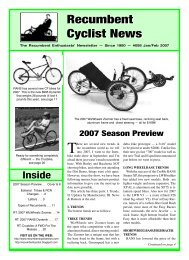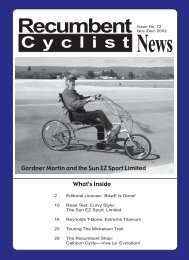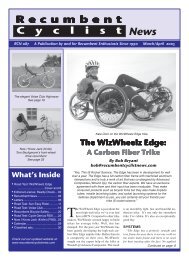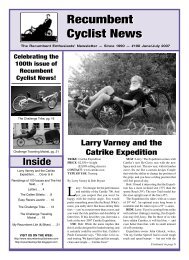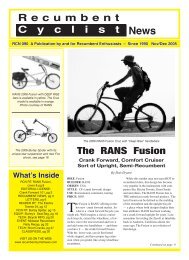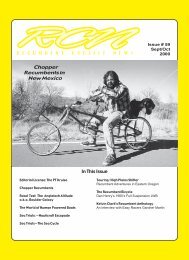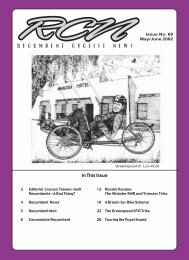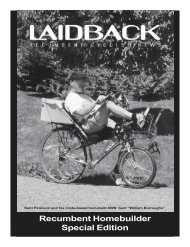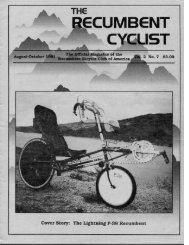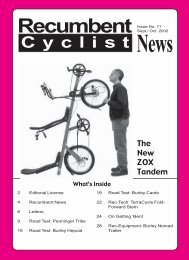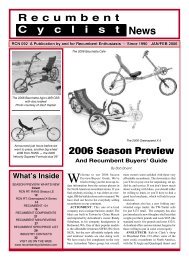C y c l i s t Recumbent - Steve Briggs
C y c l i s t Recumbent - Steve Briggs
C y c l i s t Recumbent - Steve Briggs
You also want an ePaper? Increase the reach of your titles
YUMPU automatically turns print PDFs into web optimized ePapers that Google loves.
You slip your foot in at an angle, straighten it,<br />
and the strap holds you in. Bike Nashbar also<br />
sells Power Grip brand pedals with straps.<br />
Shoes.<br />
Angletech sells SIDI shoes which are very<br />
high quality and come in wide sizes. My new<br />
bike shoes are basic Shimano SH-M021G that<br />
cost just over $50. I like them a lot and will<br />
buy another pair (one for clipless and one for<br />
platforms; and one for riding when the other<br />
pair is wet). They are relatively flat-soled and<br />
have laces instead of Velcro straps. In the past,<br />
I used Specialized MTB shoes, but they have<br />
a more contoured shape that is less walkable<br />
and I prefer my new Shimano shoes.<br />
Wheels<br />
Here are the common recumbent wheel<br />
sizes:<br />
16” 305 mm: These shorter and wider 16”<br />
size is found on recreational CLWB models.<br />
16” 349 mm: These are found on micro,<br />
folding and performance trikes.<br />
20” 406 mm: This is the BMX (bicycle<br />
motocross) standard which has now become a<br />
recumbent standard. This is the most popular<br />
and durable size of recumbent tire.<br />
20” 451 mm: This is a taller, skinnier and<br />
rarer BMX size with fewer available tire options.<br />
26” 559 mm: This is mountain bike standard,<br />
and far the most popular wheel and tire<br />
size.<br />
650c (571 mm): This is a slightly smaller<br />
road racing wheel size used primarily on<br />
highracers.<br />
700c (622 mm): This is the upright bicycle<br />
road and touring standard. Tires can be found<br />
from so skinny you wouldn’t want to ride on<br />
them up to wide city and touring sizes.<br />
Hubs<br />
The best hubs for recumbent use will be<br />
upper-end Shimano such as 105 or Ultegra, or<br />
a precision cartridge sealed bearing hub such<br />
as a Phil Wood. Hubs have been cheapened<br />
over the years. We have a 2004 model bike<br />
here with Shimano Deore hubs. The hub had<br />
to be rebuilt after 300 miles (a cone and a few<br />
bearings went bad). I asked our mechanic why<br />
this happened so quickly and he just said,<br />
“that’s what you get with entry level parts.”<br />
This bike had a mostly easy life being ridden<br />
around town by my 15 year old daughter Amy.<br />
Like cranksets, headsets, bottom brackets<br />
and wheels (parts that rotate), you don’t want<br />
to skimp on your hubs. There are many noname<br />
brand hubs spec’ed on recumbents. They<br />
may be fine, but you could end up with a problematic<br />
one such as our Deore above.<br />
22 <strong>Recumbent</strong> Cyclist News<br />
Tires<br />
Consider using slightly wider tires than you<br />
would normally use on an upright bike. Riders<br />
under about 180 pounds can ride tires<br />
smaller than 28 mm wide or less. If you are<br />
over 215 pounds, at least a 1.5” tire is suggested.<br />
The reason is that you cannot unweight<br />
your wheels on bumps as you can on a diamond-frame<br />
bicycle. Wider tires are more<br />
comfortable, less skittish to ride, and have<br />
fewer flats. Also be sure to use a tire width<br />
that is a good match for your body weight, for<br />
the cargo you carry and for the type of terrain<br />
you ride on. I don’t want to hear about any of<br />
you 200+ pounders riding on 1” wide racing<br />
tires. Excellent recumbent tires can be found<br />
from Schwalbe, Primo, Continental, Kenda<br />
and others.<br />
You’ll note our softer approach to this topic.<br />
In the past, folks like me and Zach Kaplan argued<br />
that recumbents needed much wider tires.<br />
I ride on rough roads here at the end of the<br />
known world, and I can really send a shock up<br />
my spine on some stiff-riding performanceoriented<br />
bikes and trikes. On my city bike I<br />
started riding with 1.75” 65 psi tires. They are<br />
comfortable and (so far) less prone to flats.<br />
This bike is plenty fast as well.<br />
We’re not alone in this view. Our friends at<br />
Schwalbe discuss it in their 2005 catalog: “A<br />
study conducted by Cologne Sports University<br />
showed that a full suspension bicycle is<br />
33% more comfortable to ride than a conventional<br />
bicycle. With [Schwalbe] Big Apple tires<br />
fitted to a conventional bicycle, the spine suffered<br />
around 25% less jarring … compared to<br />
a standard 700c x 35c tire.” The article goes<br />
on to discuss rolling resistance: “Using the<br />
same air pressure, wide tires roll approximately<br />
10 watts lower. With a comfortable air pressure<br />
of 30 psi the [Schwalbe] Big Apple has<br />
approximately the same rolling friction as a<br />
standard tire at 60 psi.” Big Apples come in<br />
406 mm 20”, and 559 mm 26” sizes. Besides<br />
being really nice folks, Schwalbe makes some<br />
of the best recumbent tires on the planet. We<br />
also like their tubes with all-metal valves.<br />
Wheel Rant<br />
Machine-Built Wheels: Most recumbent<br />
bicycles come with machine-built wheels.<br />
Wheel quality varies depending on where these<br />
wheels are built, who builds them and how<br />
much extra service the builder pays for (resulting<br />
in varying degrees of trueness). This is<br />
becoming more of a problem. This season I<br />
broke three spokes on three different bike<br />
wheels. All were black spokes from machinebuilt<br />
wheels from Taiwan. In all three cases<br />
the wheels had been carefully tensioned and<br />
trued at set-up. In two of the cases the wheels<br />
were deemed problematic and needed to be<br />
rebuilt after a few hundred miles. Wheel-building<br />
machines were created for making large<br />
production runs of identical wheels very<br />
cheaply. Inside this mega-machine, the wheel<br />
is laced, tensioned and trued — all in a matter<br />
of minutes. One report I read called this, “a<br />
very brutal process.” Many of these wheels are<br />
just crap and at the very least the wheels are<br />
disposable. I think there is a good argument<br />
for just throwing out a problematic wheel and<br />
starting over with all new parts.<br />
Hand-Built Wheels: This is an option that<br />
you don’t hear enough about. To create a handbuilt<br />
wheel, a skilled wheel builder collects<br />
the necessary high-quality parts. The spokes<br />
are then laced and evenly tensioned by hand,<br />
and then the truing process begins until the<br />
wheel is perfectly round. There are custom<br />
wheel builders in larger towns. There are a few<br />
on the Internet as well. Often they will offer a<br />
time or mileage guarantee on their wheels.<br />
Really good bike shops will allow you to upgrade<br />
from machine-built to hand-built wheels<br />
at the time of purchase. If you are a big or<br />
strong rider and really depend on your bike,<br />
you should seriously consider this option.<br />
Paired-spoke Wheels: We’ve heard some<br />
good things (from qualified sources close to<br />
RCN) about paired-spoke wheels, particularly<br />
the Rolf and Bontrager brands. We’ve had<br />
good luck with others during our tests. However,<br />
we didn’t put enough miles on any of<br />
them to know for sure about long term durability.<br />
Most of these wheels have 20 or 24<br />
spokes and they cannot be repaired as easily,<br />
nor are they as durable as a regular-spoked<br />
wheel.<br />
Spokes in general: Most bikes have three<br />
different sizes of spokes, one for the front<br />
wheel, one for the rear wheel drive side, and<br />
one for the non-drive side. We recommend that<br />
you buy a few extra spokes for each size on<br />
your bike or trike. Finding spokes, especially<br />
for smaller wheels will be difficult — and even<br />
more so if they are black. I needed a 20” black<br />
spoke earlier in the year and had to have it cut<br />
by my local shop. Even a 26” black spoke was<br />
difficult to find.<br />
Well there you have it: my personal views<br />
on recumbent bicycle component options. My<br />
final thought for you is to become educated<br />
yourself. Surf the web, read some books and<br />
hang out in bike shops to learn more about bike<br />
stuff. Enjoy your education and form your own<br />
opinions based on your body, bikes and how<br />
and where you ride.<br />
Durability<br />
Durability is the number one issue for me<br />
when I select bicycle components for real<br />
world use. I use my bicycles and RCN test<br />
bikes as daily transportation. I ride my 12 mile<br />
round trip commute to the post office twice<br />
daily — rain or shine. If you have received<br />
mail from RCN, the odds are good that it was<br />
delivered to the post office by bike.<br />
For those of you who are under 160 pounds<br />
and ride on Saturdays down the bike trail or<br />
around the block — buy whatever you want.<br />
If you are heavy, carry a load, or commute at<br />
all — cheap parts will come back to haunt you.



